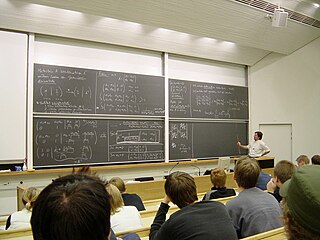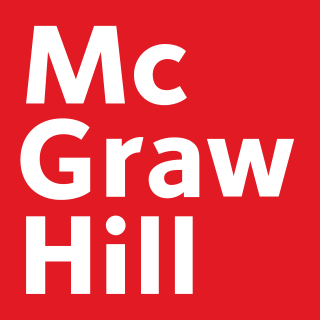Related Research Articles

In contemporary education, mathematics education—known in Europe as the didactics or pedagogy of mathematics—is the practice of teaching, learning, and carrying out scholarly research into the transfer of mathematical knowledge.

In education, a curriculum is broadly defined as the totality of student experiences that occur in the educational process. The term often refers specifically to a planned sequence of instruction, or to a view of the student's experiences in terms of the educator's or school's instructional goals. A curriculum may incorporate the planned interaction of pupils with instructional content, materials, resources, and processes for evaluating the attainment of educational objectives. Curricula are split into several categories: the explicit, the implicit, the excluded, and the extracurricular.
Sixth grade is the sixth year of schooling. Students are typically 11–12 years old, depending on when their birthday occurs. Different terms and numbers are used in parts of the world. It is commonly the first or second grade of middle school, and the sixth school year since kindergarten.
Seventh grade is a year or level of education. The seventh grade is the eighth school year, the second or third year of middle school, and the first year of junior high school. Students are around 12-13 years old in this stage of education. Different terms and numbers are used in other parts of the world.
Eighth grade is the eighth post-kindergarten year of required education in the US. The eighth grade is the ninth school year, the second, third, fourth, or final year of middle school, or the second and/or final year of junior high school, and comes after 7th grade. Usually, students are 13-14 years old in this stage of education. Different terms and numbers are used in other parts of the world.

Core-Plus Mathematics is a high school mathematics program consisting of a four-year series of print and digital student textbooks and supporting materials for teachers, developed by the Core-Plus Mathematics Project (CPMP) at Western Michigan University, with funding from the National Science Foundation. Development of the program started in 1992. The first edition, entitled Contemporary Mathematics in Context: A Unified Approach, was completed in 1995. The third edition, entitled Core-Plus Mathematics: Contemporary Mathematics in Context, was published by McGraw-Hill Education in 2015.
Investigations in Numbers, Data, and Space is a K–5 mathematics curriculum, developed at TERC in Cambridge, Massachusetts, United States. The curriculum is often referred to as Investigations or simply TERC. Patterned after the NCTM standards for mathematics, it is among the most widely used of the new reform mathematics curricula. As opposed to referring to textbooks and having teachers impose methods for solving arithmetic problems, the TERC program uses a constructivist approach that encourages students to develop their own understanding of mathematics. The curriculum underwent a major revision in 2005–2007.
Science Research Associates (SRA) was a Chicago-based publisher of educational materials and schoolroom reading comprehension products. The company was acquired by McGraw-Hill Education in the early 2000s.
Math wars is the debate over modern mathematics education, textbooks and curricula in the United States that was triggered by the publication in 1989 of the Curriculum and Evaluation Standards for School Mathematics by the National Council of Teachers of Mathematics (NCTM) and subsequent development and widespread adoption of a new generation of mathematics curricula inspired by these standards.
Learning standards are elements of declarative, procedural, schematic, and strategic knowledge that, as a body, define the specific content of an educational program. Standards are usually composed of statements that express what a student knows, can do, or is capable of performing at a certain point in their '''learning progression'''.
Zalman Usiskin is an educator best known as the Director of the University of Chicago School Mathematics Project.
Everyday Mathematics is a pre-K and elementary school mathematics curriculum, developed by the University of Chicago School Mathematics Project. The program, now published by McGraw-Hill Education, has sparked debate.
Connected Mathematics is a comprehensive mathematics program intended for U.S. students in grades 6-8. The curriculum design, text materials for students, and supporting resources for teachers were created and have been progressively refined by the Connected Mathematics Project (CMP) at Michigan State University with advice and contributions from many mathematics teachers, curriculum developers, mathematicians, and mathematics education researchers.
Reform mathematics is an approach to mathematics education, particularly in North America. It is based on principles explained in 1989 by the National Council of Teachers of Mathematics (NCTM). The NCTM document Curriculum and Evaluation Standards for School Mathematics (CESSM) set forth a vision for K–12 mathematics education in the United States and Canada. The CESSM recommendations were adopted by many local- and federal-level education agencies during the 1990s. In 2000, the NCTM revised its CESSM with the publication of Principles and Standards for School Mathematics (PSSM). Like those in the first publication, the updated recommendations became the basis for many states' mathematics standards, and the method in textbooks developed by many federally-funded projects. The CESSM de-emphasised manual arithmetic in favor of students developing their own conceptual thinking and problem solving. The PSSM presents a more balanced view, but still has the same emphases.
From kindergarten through high school, mathematics education in public schools in the United States has historically varied widely from state to state, and often even varies considerably within individual states. Moreover, many students take alternatives to the traditional pathways, including accelerated tracks. As of 2023, twenty-seven states require students to pass three math courses before graduation from high school, but seventeen states and the District of Columbia require four.
The Common Core State Standards Initiative, also known as simply Common Core, is an educational initiative from 2010 that details what K–12 students throughout the United States should know in English language arts and mathematics at the conclusion of each school grade. The initiative is sponsored by the National Governors Association and Council of Chief State School Officers.
Project SEED was a mathematics education program which worked in urban school districts across the United States. Project SEED was a nonprofit organization that worked in partnership with school districts, universities, foundations, and corporations to teach advanced mathematics to elementary and middle school students as a supplement to their regular math instruction. Project SEED also provided professional development for classroom teachers. Founded in 1963 by William F. Johntz, its primary goal was to use mathematics to increase the educational options of low-achieving, at-risk students.
The Secondary School Mathematics Curriculum Improvement Study (SSMCIS) was the name of an American mathematics education program that stood for both the name of a curriculum and the name of the project that was responsible for developing curriculum materials. It is considered part of the second round of initiatives in the "New Math" movement of the 1960s. The program was led by Howard F. Fehr, a professor at Columbia University Teachers College.

McGraw Hill is an American educational publishing company and one of the "big three" educational publishers that publishes educational content, software, and services for pre-K through postgraduate education. The company also publishes reference and trade publications for the medical, business, and engineering professions. McGraw Hill operates in 28 countries, has about 4,000 employees globally, and offers products and services to about 140 countries in about 60 languages. Formerly a division of The McGraw Hill Companies, McGraw Hill Education was divested and acquired by Apollo Global Management in March 2013 for $2.4 billion in cash. McGraw Hill was sold in 2021 to Platinum Equity for $4.5 billion.

In the United States, elementary schools are the main point of delivery of primary education, for children between the ages of 5–11 and coming between pre-kindergarten and secondary education.
References
- 1 2 Senk, Sharon L. (1 September 2003). "Effects of the UCSMP Secondary School Curriculum on Students' Achievement". In Sharon L. Senk and Denisse R. Thompson (ed.). Standards-Based School Mathematics Curricula: What Are They? What Do Students Learn?. Routledge. p. 425. ISBN 978-0-8058-5028-4 . Retrieved 5 April 2010.